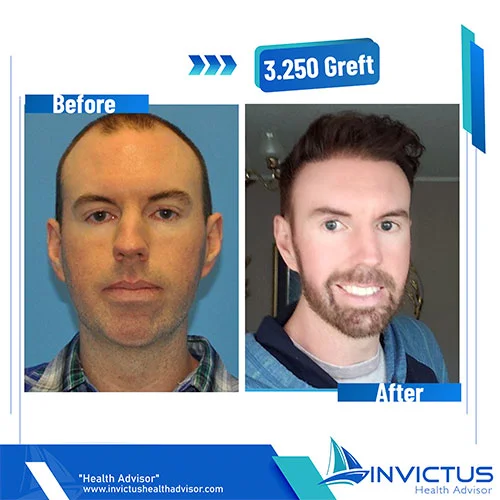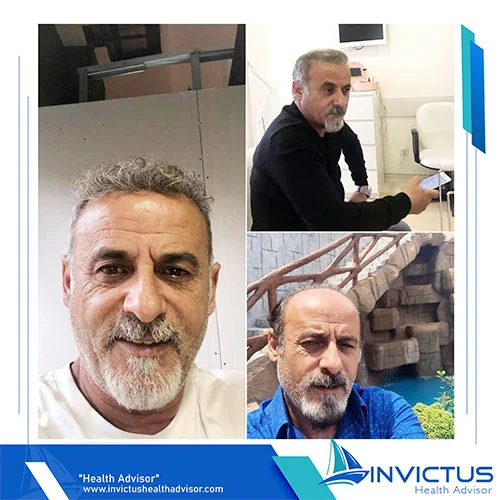Free Consultation Form
Hair transplantation is a surgical procedure used to provide a permanent solution to people experiencing hair loss and baldness problems. In this procedure, healthy hair follicles taken from the scalp are transplanted to the areas where hair loss and thinning occur, creating a natural and permanent hairline.
WHY CHOOSE INVICTUS HEALTH ADVISOR
Hair Transplantation Methods
Hair Transplantation with FUE Technique
In the FUE technique, hair follicles are taken from the scalp one by one with microsurgical tools. Hair follicles taken from the donor areas; the back of the neck or the side areas are transplanted to the area where the transplantation will be made. Since the FUE method involves fewer incisions and interventions, the healing process is faster and does not leave permanent scars such as stitches.
Hair Transplantation with DHI Technique
It is one of the hair transplantation techniques and is a derivative of the traditional FUE technique. The DHI technique is an approach that allows the direct transplantation of hair follicles using a special device instead of opening channels in the areas where the hair follicles will be transplanted.
With this technique, hair follicles are carefully placed in the recipient area in the areas where hair is thin or hairless. The main advantage of DHI is that the hair follicles can be placed faster and more effectively and the hair follicles are left outside less, which helps the transplanted hair follicles to be healthier.
Steps Applied in Hair Transplantation Procedure
- The area where the hair will be transplanted is prepared as the area where the hair follicles will be extracted one by one from the scalp.
- The hair follicles are extracted one by one using a special device. This device carefully selects and extracts the hair follicles so that healthy and strong roots can be transplanted.
- The extracted hair follicles are transplanted directly to the balding or sparse areas using a special device or an applicator resembling a pen. This applicator helps to achieve a natural hairline and density by placing the hair follicles precisely.
- After the hair transplantation procedure, small crusts in the recipient area heal within a few days and new hair begins to grow naturally. The full recovery process may vary from person to person, but is usually completed within a few weeks.
What to Consider After Hair Transplantation?
- Rest and Minimum Movement: It is important to rest for the first few days after hair transplantation. Limiting physical activities and not exerting excessive effort can increase blood flow in the transplanted area and help the grafts settle successfully.
- Protecting the Hair Transplanted Area: It is important to protect the hair transplanted area against impacts and friction. You should avoid irritating the haired area, especially in the first days.
- Using Appropriate Pillows: Keeping your head elevated while sleeping for the first few days is important to reduce swelling and regulate blood flow. For this reason, you can arrange pillows to support the transplanted area.
- Regular Medication Use: You should regularly use the medications prescribed by your doctor. These medications are given to reduce the risk of infection and speed up healing.
- Regular Medication Use: You should regularly use the medications prescribed by your doctor. These medications are given to reduce the risk of infection and speed up healing.
- Preventing Itching: Itching is normal after hair transplantation, but you should definitely avoid scratching the scalp. This can cause the transplanted grafts to fall out or get damaged.
- Careful Hair Washing: You should be careful about washing and shampooing your hair for the period determined by your doctor after hair transplantation. Generally, washing your hair can be avoided for 2-3 days after transplantation or special instructions should be followed.
- Avoiding Alcohol and Smoking: It is important to avoid alcohol consumption and smoking after hair transplantation. This can negatively affect the healing process.
- Regular Doctor Check-ups: You should have regular check-ups determined by your doctor after hair transplantation. This is important to follow the healing process and make the necessary interventions.

Hair Transplantation Before & After
Hair Transplantation Operation Overview
Let’s Plan Your Treatment Together in Turkey
PLAN YOUR TREATMENT IN TURKEY
Let us share with you how this magnificent transformation adventure, which begins from the moment you meet us, works.
ONLINE MEETING
VIP TRANSFER
We welcome you at the airport and bring you to our clinic safely in private vehicles.
YOU ARE OUR GUEST
We offer hotel accommodation during your treatment stay.
TREATMENT
Your doctor will create a plan. Surgery takes 3-4 hours, followed by a 1-night stay. After a final check-up, you’ll be discharged.
INTERPRETER SUPPORT
Enjoy healthcare in your own language with interpreter support before, during, and after treatment.
Free Consultation Form
Frequently Asked Questions About Hair Transplantation!
Hair transplantation is the process of transplanting a person’s own hair follicles to areas where hair has fallen out or thinned. Hair follicles taken from the nape area are usually used for transplantation.
It is suitable for individuals who have experienced hair loss and have sufficient hair follicles in the donor areas and whose general health is good.
The most common methods are FUE (Follicular Unit Extraction) and DHI (Direct Hair Transplantation) techniques. Local anesthesia is applied, hair follicles are taken from the donor area and transferred to the area where the transplant will be performed.
Since the procedure is performed under local anesthesia, no pain is felt. There may be slight sensitivity after the procedure, but this can usually be controlled with painkillers.
Depending on the number of grafts to be transplanted, the procedure can take between 4-8 hours.
The transplanted hair starts to grow within 3-4 months, but the final results are usually seen within 12-18 months.
Yes, transplanted hair follicles are genetically resistant to shedding and are permanent. However, natural hair may continue to fall out.
Yes, when performed by an experienced specialist, hair transplant provides a natural look and the transplanted hair grows like the person’s own hair.
Patients can usually return to their daily activities within 1-2 days. Scabbing and redness disappear within 7-10 days. The transplanted hair falls out within a few weeks and then starts to grow permanently.
Prices vary depending on the number of grafts to be transplanted, the technique used, the location of the clinic and the experience of the doctor.
It is generally recommended for people over the age of 20 and whose hair loss has already started.
The transplanted area should not be touched for the first few days. Heavy sports activities should be avoided for 10 days. The shampoos and lotions recommended by the doctor should be used.
We Continue to Be a Secure Bridge Between You and Turkey!

In order to ensure reliability in health tourism, the Turkish Ministry of Health requires intermediary service organisations such as us and health institutions to fulfil certain competence criteria. Organisations that can fulfil these criteria are entitled to receive the International Health Tourism Authorisation Certificate and prove that they are a reliable organisation in the sector.










